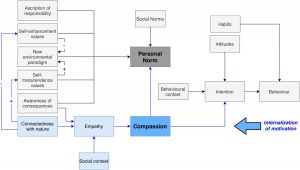
Improve Mental Health and Blood Biomarker Levels with Meditation and Yoga
By John M. de Castro, Ph.D.
“The main purpose of meditation is to access, recognize and enhance the positive qualities of mind. The more we can do this, the less we need to rely on external situations for our happiness and the more we can rely on the natural, positive qualities of mind: love, contentment, well-being and peace.” – Trinlay Rinpoche
Over the last several decades, research and anecdotal experiences have accumulated an impressive evidential case that the development of mindfulness has positive benefits for the individual’s mental, physical, and spiritual life. Mindfulness appears to be beneficial both for healthy people and for people suffering from a myriad of mental and physical illnesses. It appears to be beneficial across ages, from children to the elderly. And it appears to be beneficial across genders, personalities, race, and ethnicity. The breadth and depth of benefits is unprecedented. There is no other treatment or practice that has been shown to come anyway near the range of mindfulness’ positive benefits.
It is not known exactly how mindfulness training produces these benefits. It is possible that one mechanism is by altering blood bourn hormonal levels. In today’s Research News article “Inner Engineering Practices and Advanced 4-day Isha Yoga Retreat Are Associated with Cannabimimetic Effects with Increased Endocannabinoids and Short-Term and Sustained Improvement in Mental Health: A Prospective Observational Study of Meditators.” (See summary below or view the full text of the study at: https://www.ncbi.nlm.nih.gov/pmc/articles/PMC7293737/ ) Sadhasivam and colleagues recruited healthy adults and had them attend a 4-day intensive training in yoga and meditation. Before and after the training and 1 month later they were measured for mindfulness, happiness, anxiety, depression, and psychological well-being. They also drew blood before and after training and assayed it for the brain-derived neurotrophic factor (BDNF), and the biomarkers of Endocannabinoids, (anandamide, 2-arachidonoylglycerol (2-AG), 1-arachidonoylglycerol (1-AG), docosatetraenoylethanolamide (DEA), and oleoylethanolamide (OLA)).
They found that after the training there were significant decreases in anxiety and depression and significant increases in mindfulness, happiness, and psychological well-being. These changes were maintained at the 1-month follow-up. There were also significant increases in all of the blood biomarkers of Endocannabinoids and also brain-derived neurotrophic factor (BDNF).
It should be kept in mind that this was a pilot study that did not have a control, comparison, condition. So, the results might have been due to a number of confounding factors rather than the training itself. But previous controlled research has convincingly demonstrated that mindfulness training increases happiness, and psychological well-being and decreases anxiety and depression. So, these changes were likely due to the training.
There were also novel findings in the present study that Endocannabinoids and brain-derived neurotrophic factor (BDNF) were significantly increased by the training. These provide objective measures of the subjective reports of psychological improvements. Endocannabinoids in the blood are associated with positive mood states. BDNF is a neurotrophic factor that is thought to signal neuroplastic changes in the nervous system. Mindfulness training has been previously shown to produce neuroplastic changes in the brain. So, the increases in these biomarkers indicate that the training not only improves the psychological health of the participants but also alters the brain, perhaps making the improvements longer lasting. This suggests a potential mechanism for the ability of meditation and yoga to improve mood, by increasing hormones that improve mood.
So, improve mental health and blood biomarker levels with meditation and yoga.
“The more you practice invoking states of well-being, the more available they are. Use the following practice to teach your mind and body to experience joy in the moment. As you invite happiness into your life in this way, you will have more access to a joyful life.” – Yoga Journal
CMCS – Center for Mindfulness and Contemplative Studies
This and other Contemplative Studies posts are also available on Google+ https://plus.google.com/106784388191201299496/posts and on Twitter @MindfulResearch
Study Summary
Sadhasivam, S., Alankar, S., Maturi, R., Vishnubhotla, R. V., Mudigonda, M., Pawale, D., Narayanan, S., Hariri, S., Ram, C., Chang, T., Renschler, J., Eckert, G., & Subramaniam, B. (2020). Inner Engineering Practices and Advanced 4-day Isha Yoga Retreat Are Associated with Cannabimimetic Effects with Increased Endocannabinoids and Short-Term and Sustained Improvement in Mental Health: A Prospective Observational Study of Meditators. Evidence-based complementary and alternative medicine : eCAM, 2020, 8438272. https://doi.org/10.1155/2020/8438272
Abstract
Background
Anxiety and depression are common in the modern world, and there is growing demand for alternative therapies such as meditation. Meditation can decrease perceived stress and increase general well-being, although the physiological mechanism is not well-characterized. Endocannabinoids (eCBs), lipid mediators associated with enhanced mood and reduced anxiety/depression, have not been previously studied as biomarkers of meditation effects. Our aim was to assess biomarkers (eCBs and brain-derived neurotrophic factor [BDNF]) and psychological parameters after a meditation retreat.
Methods
This was an observational pilot study of adults before and after the 4-day Isha Yoga Bhava Spandana Program retreat. Participants completed online surveys (before and after retreat, and 1 month later) to assess anxiety, depression, focus, well-being, and happiness through validated psychological scales. Voluntary blood sampling for biomarker studies was done before and within a day after the retreat. The biomarkers anandamide, 2-arachidonoylglycerol (2-AG), 1-arachidonoylglycerol (1-AG), docosatetraenoylethanolamide (DEA), oleoylethanolamide (OLA), and BDNF were evaluated. Primary outcomes were changes in psychological scales, as well as changes in eCBs and BDNF.
Results
Depression and anxiety scores decreased while focus, happiness, and positive well-being scores increased immediately after retreat from their baseline values (P < 0.001). All improvements were sustained 1 month after BSP. All major eCBs including anandamide, 2-AG, 1-AG, DEA, and BDNF increased after meditation by > 70% (P < 0.001). Increases of ≥20% in anandamide, 2-AG, 1-AG, and total AG levels after meditation from the baseline had weak correlations with changes in happiness and well-being.
Conclusions
A short meditation experience improved focus, happiness, and positive well-being and reduced depression and anxiety in participants for at least 1 month. Participants had increased blood eCBs and BDNF, suggesting a role for these biomarkers in the underlying mechanism of meditation. Meditation is a simple, organic, and effective way to improve well-being and reduce depression and anxiety.
https://www.ncbi.nlm.nih.gov/pmc/articles/PMC7293737/









